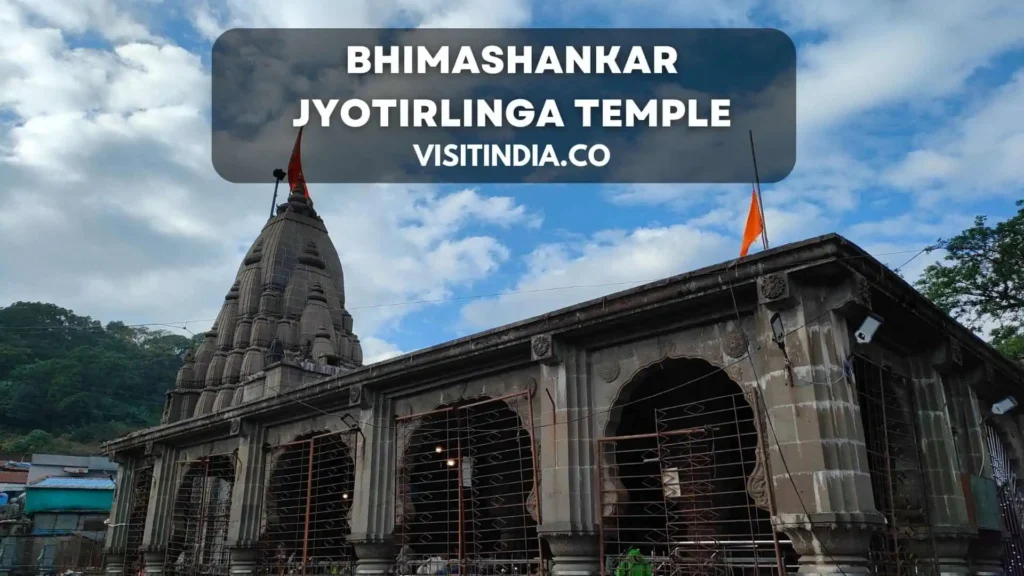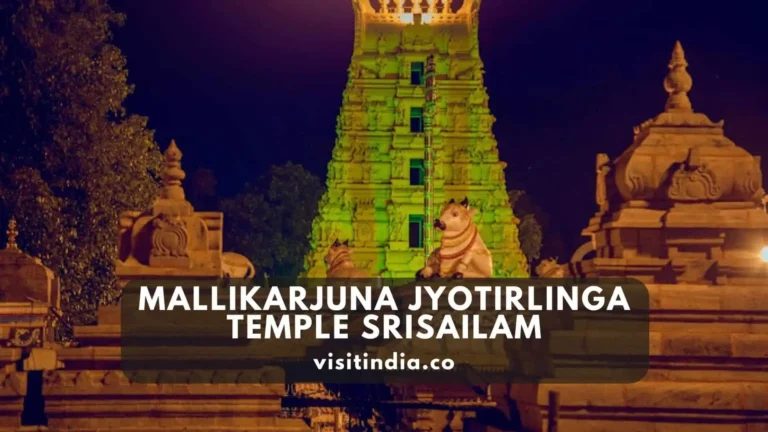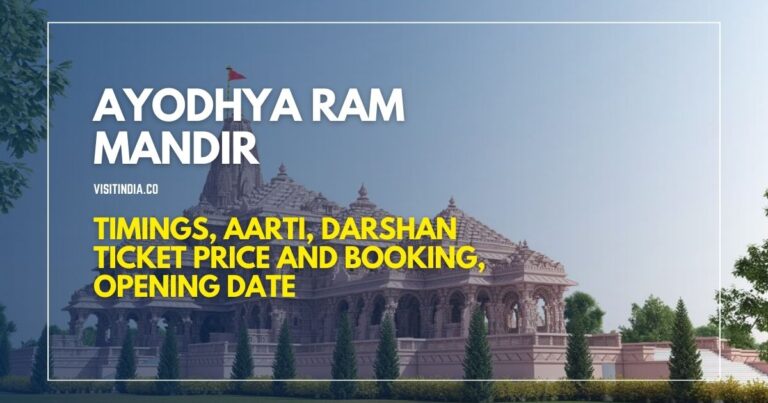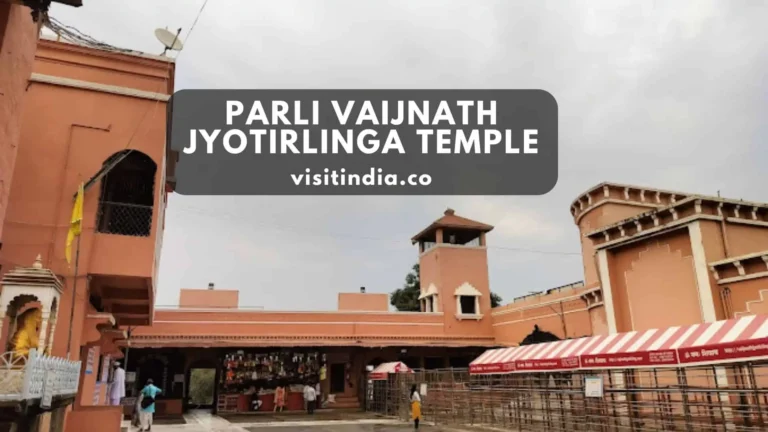Bhimashankar Jyotirlinga Temple Timings, History, Significance, Facts, Pooja
Welcome to our article on Bhimashankar Jyotirlinga temple, one of the twelve sacred Jyotirlingas of Lord Shiva. Nestled in the ancient Kamrup region of Assam, this mythological site holds great significance for devotees across India. Despite recent controversies, Assam Chief Minister Dr. Himanta Biswa Sarma has affirmed that the Bhimashankar Jyotirlinga is indeed located in Kamrup, as stated in the Shiva Puran.

To reach this divine temple, one must descend around 200 steps, offering a unique experience compared to other Jyotirlingas that require climbing stairs. The sanctum of the temple is adorned with Nandi Maharaj and Kachhap Dev, creating a serene and sacred atmosphere.
Join us as we delve deeper into the significance, history, and spiritual journey associated with Bhimashankar Jyotirlinga. Discover the timeless allure of this divine abode and the stories that have captivated the hearts of millions of devotees.
Consider reading: 12 Jyotirlingas in India Name, Location, Significance and Details
Bhimashankar Jyotirlinga Temple Timings
To plan your visit to the sacred Bhimashankar Jyotirlinga Temple, it is important to be aware of the temple timings. Here are the detailed timings for various rituals and darshan at the temple:
- Darshan: The temple opens at 4:30 AM and closes at 9:30 PM. Devotees can have the darshan of Lord Shiva during these times.
- Morning Aarti: Start your day with the divine morning aarti at Bhimashankar Jyotirlinga Temple. During the morning aarti, devotees can witness the enchanting rituals performed to seek the blessings of Lord Shiva. The morning aarti timings are from 4:30 AM to 5:00 AM.
- Morning Darshan: Along with the morning aarti, devotees can also have the darshan of the deity from 4:30 AM to 3:15 PM. Experience tranquility and spirituality as you offer your prayers to Lord Shiva.
- Evening Darshan: The temple reopens for evening darshan from 4:00 PM to 9:30 PM. Witness the temple’s serene ambiance and seek blessings from the divine deity.
- Nijarupa Darshan: The Nijarupa darshan, which represents Lord Shiva’s true form, is available from 5:00 AM to 5:30 AM. It’s a sublime experience to witness the true essence of the deity during this special darshan.
- Shringar Darshan: The Shringar Darshan is available from 4:00 PM to 4:30 PM. This darshan offers a chance to see Lord Shiva adorned with beautiful decorations and jewelry, enhancing the divine presence of the deity.
- Evening Aarti: Conclude your day with the blissful evening aarti at Bhimashankar Jyotirlinga Temple. The evening aarti timings are from 7:30 PM to 8:00 PM. Immerse yourself in the devotional atmosphere and soak in the spiritual energy.
Please note that these timings are subject to change, so it’s always advisable to check with the temple authorities or their official website for any updates or specific timings on the day of your visit.
Consider reading: Nageshwar Jyotirlinga Temple Timings, Entry Fees, How to Reach, History, Festivals
History Of Bhimashankar Jyotirlinga Temple
The Bhimashankar Jyotirlinga Temple has a rich history dating back to ancient times. As one of the 12 Jyotirlingas in India, it holds significant religious importance for devotees. Here are some key historical facts about the temple:
- Ancient Legend: According to the Shiva Mahapurana, Lord Shiva appeared as a vibrant column of light in 12 different places across India, known as Jyotirlingas. Bhimashankar Jyotirlinga is one of these divine sites.
- Mythical Connection: The temple derives its name from the legend of Bhima, the mighty Pandava prince from the Hindu epic, Mahabharata. It is believed that Bhima sanctified this place to seek forgiveness from Lord Shiva after killing the demon Tripurasura.
- Architectural Marvel: The Bhimashankar Jyotirlinga Temple is not only a place of religious significance but also an architectural marvel. Surrounded by lush greenery and located beside the Bhima River, the temple showcases a blend of ancient and contemporary architectural styles.
- Historical Significance: The temple has undergone several renovations and expansions over the centuries. It has witnessed the patronage of various rulers, including the Marathas, who contributed to its magnificence.
- Devotee Popularity: The temple attracts a large number of devotees from all over the country who come to seek blessings and experience the divine presence of Lord Shiva. It remains a sacred site for Hindus and plays a vital role in their religious and spiritual lives.
Exploring the history of the Bhimashankar Jyotirlinga Temple not only enhances our knowledge but also adds depth to our spiritual journey. Remember to check with the temple authorities or their official website for any updates or specific timings before visiting this revered place.
Consider reading: Trimbakeshwar Jyotirlinga Temple Timings, Entry Fees, History, Significance, How to Reach
Places To Visit In Bhimashankar
When visiting the Bhimashankar Jyotirlinga Temple, there are several other places nearby that are worth exploring. Here are some of the top attractions to visit in Bhimashankar:
- Gupt Bhimashankar: Located just a short trek from the main temple, Gupt Bhimashankar is the place where the Jyotirlinga was discovered. Surrounded by lush greenery and situated on the banks of a waterfall, this serene location offers a unique and peaceful experience.
- Sakshi Ganapati Temple: Situated 2 km away from the Bhimashankar temple, the Sakshi Ganapati Temple is dedicated to Lord Ganapati. The deity here is known as “Sakshi” because he is believed to be the witness to the visits of pilgrims to the Jyotirlinga. Pay your respects to Lord Ganapati and Lord Shiva at this temple.
- Kamalaja Devi Temple: This temple is dedicated to Goddess Parvati, the wife of Lord Shiva. Legend has it that she played a vital role in Lord Shiva’s battle against the demons. In this temple, Goddess Kamalaja is depicted sitting on a lotus, representing her beauty and grace.
- Kamalaja Kund: Pay a visit to Kamalaja Kund, a sacred pond created by sage Kaushik with water from his kamandal. It is said that the river Bhima emerged from this pond to honor the sage’s penance. The ancestors of Ruchik, a disciple of sage Kaushik, bathed in this holy river and attained salvation.
- Bhimashankar Wildlife Sanctuary: If you’re a nature enthusiast, make sure to explore the Bhimashankar Wildlife Sanctuary. Spread over an area of 130 square kilometers, this sanctuary is known for its rich biodiversity and lush green forests. Keep an eye out for various species of mammals, birds, and reptiles that call this sanctuary their home.
Remember to check with the temple authorities or their official website for any updates or specific timings before visiting these places.
Consider reading: Kedarnath Jyotirlinga Temple Timing, How to Reach, Significance, History
Spiritual Significance Of Jyotirlinga Bhimashankar
The Bhimashankar Jyotirlinga holds immense spiritual significance for Hindus and devotees of Lord Shiva. As one of the 12 Jyotirlingas in India, it is believed to be a self-manifested representation of Lord Shiva’s divine form. Pilgrims from around the world visit this sacred site to seek blessings, spiritual enlightenment, and the purification of their souls.
Devotees firmly believe that offering prayers and performing rituals at Bhimashankar can bring peace, prosperity, and the removal of sins. The serene ambiance of the temple, surrounded by lush forests and the melodious flow of the Bhima River, enhances the spiritual experience and fosters a deep connection with the divine.
Here are some key aspects of the spiritual significance of Jyotirlinga Bhimashankar:
- Ancient Legend: The Bhimashankar Temple is shrouded in captivating myths and legends that enrich its cultural and spiritual significance. These myths add a layer of mystique to the temple’s history and attract devotees and tourists alike.
- Purification and Blessings: Devotees believe that by offering prayers and performing rituals at Bhimashankar, they can cleanse their souls and receive the blessings of Lord Shiva.
- Divine Connection: The temple’s status as one of the 12 Jyotirlingas strengthens the belief that Bhimashankar is a direct manifestation of Lord Shiva. This divine connection inspires devotees to deepen their faith and devotion.
- Seeking Enlightenment: Many pilgrims visit Bhimashankar with the hope of attaining spiritual enlightenment. The tranquil environment and sacred atmosphere of the temple provide an ideal setting for introspection and self-realization.
Visiting the Jyotirlinga Bhimashankar is an opportunity to experience a profound spiritual journey. The devotion and piety of the pilgrims, combined with the history and significance of the temple, create an atmosphere of transcendence that leaves a lasting impact on the hearts and minds of those who visit.
Consider reading: Grishneshwar Jyotirlinga Temple Timings, Entry Fee, How to Reach, History, Facts
Architectural Marvel Of Bhimashankar Jyotirlinga Temple
The Bhimashankar Jyotirlinga Temple is not only a place of religious significance but also an architectural marvel that captivates visitors with its grandeur and beauty. Here are some key features that make it stand out:
- Ancient Design: The temple showcases the architectural style of the Nagara or North Indian school of temple architecture. It follows a tri-pinnacle (trikonasana) design, which is characteristic of many ancient Indian temples. The overall structure is adorned with intricate carvings and sculptures, depicting various mythological stories and deities.
- Stone Carvings: The walls of the temple are adorned with exquisite stone carvings that showcase the skilled craftsmanship of the artisans. These carvings depict scenes from Hindu mythology, including stories from the Ramayana and Mahabharata. Each carving is painstakingly crafted, reflecting the devotion and dedication of the artisans.
- Sculptures and Pillars: The temple is adorned with numerous stone sculptures and intricately carved pillars, adding to its architectural splendor. The pillars are intricately designed with motifs and geometric patterns, creating a visually stunning effect. These sculptures and pillars are a testament to the rich heritage and artistic traditions of ancient India.
- Spire and Shikhara: The temple’s towering spire (shikara) is a sight to behold. It rises high into the sky, symbolizing the divine presence of Lord Shiva. The spire is adorned with intricate carvings and architectural details, showcasing the skill and craftsmanship of the architects and artisans who built the temple.
- Peaceful Ambiance: The architectural design of the Bhimashankar Jyotirlinga Temple creates a serene and peaceful ambiance, ideal for devotees seeking spiritual solace. The temple’s location amidst lush greenery and the soothing sound of the Bhima River flowing nearby adds to the overall tranquil atmosphere.
Visiting the Bhimashankar Jyotirlinga Temple is not only a religious experience but also an opportunity to appreciate the architectural brilliance of ancient India. The intricate carvings, stone sculptures, and towering spire all contribute to the unique charm of this architectural marvel.
Consider reading: Kashi Vishwanath Temple Timings, Entry Fees, How to Reach, History, Facts, Significance
Key Facts About Bhimashankar Jyotirlinga Temple
The Bhimashankar Jyotirlinga Temple is a renowned sacred site in Maharashtra, India, dedicated to Lord Shiva. Here are some key facts about this ancient temple:
- Importance as a Jyotirlinga: The Bhimashankar Jyotirlinga Temple is one of the 12 Jyotirlingas in India that hold immense religious significance for Hindus. These Jyotirlingas are believed to be self-manifested representations of Lord Shiva’s divine form. Worshipping at these shrines is considered highly auspicious and is believed to bring spiritual blessings and liberation from sins.
- Historical Legacy: The origins of the Bhimashankar Temple are deeply rooted in Hindu mythology and legends. According to Shiva Mahapurana, Lord Shiva appeared in 12 different places in India as a radiant column of light. The Bhimashankar Jyotirlinga is one of these sacred sites and remains a significant religious place for devotees, as well as an architectural marvel.
- Connection to Bhima River: The temple derives its name from the Bhima River, also known as Chandrabhaga. According to ancient tales, the river was formed during a fierce battle between Lord Shiva and the demon Tripurasura. The Bhimashankar Temple stands as a testimony to this divine event and is considered a revered spot where devotees can connect with the divine presence of Lord Shiva.
- Spiritual Significance: Visiting the Bhimashankar Jyotirlinga Temple is believed to bring peace, prosperity, and spiritual enlightenment. The tranquil surroundings of lush forests and the melodious flow of the Bhima River enhance the spiritual experience, allowing devotees to immerse themselves in the divine ambiance and seek blessings for themselves and their loved ones.
- Architectural Marvel: The Bhimashankar Temple showcases the brilliance of ancient Indian architecture. The temple’s design features intricate stone carvings, sculptures, and pillars that depict various mythological incidents and deities associated with Lord Shiva. The spire (shikhara) of the temple stands tall as a remarkable testament to the skilled craftsmanship of the bygone era.
Consider reading: Omkareshwar Jyotirlinga Temple Timings, Parikrama, Distance, Facts, Significance
Poojas and Ceremonies at Bhimashankar Jyotirlinga Temple
At Bhimashankar Jyotirlinga Temple, devotees have the opportunity to perform various poojas and ceremonies, allowing them to connect deeply with the divine and seek blessings from Lord Shiva. Here are some of the important rituals that take place at the temple:
- Abhishekam: Abhishekam refers to the ceremonial bath of the Jyotirlinga. Pilgrims can perform Abhishekam using milk, water, honey, etc. This sacred act is believed to purify one’s soul and remove sins, fostering spiritual enlightenment.
- Poojas: The temple administration allows devotees to conduct poojas to the Jyotirlinga by themselves. With marigold and Bilva leaves, devotees can offer their prayers and show their utmost devotion to the divine. This personal connection enhances the spiritual experience and creates a sense of fulfillment.
- Special Ceremonies: Bhimashankar Jyotirlinga Temple also hosts special ceremonies and festivals throughout the year. These occasions attract a large number of devotees who come to witness and participate in the divine festivities. These ceremonies create an atmosphere of joy, devotion, and spiritual awakening.
Performing these rituals at Bhimashankar Jyotirlinga Temple is believed to bring inner peace, prosperity, and spiritual enlightenment. It allows devotees to immerse themselves in the sacredness of the temple and seek solace in the presence of Lord Shiva.
The Bhimashankar Jyotirlinga Temple’s status as one of the 12 Jyotirlingas in India further adds to its significance and attracts devotees from all around the country. These 12 Jyotirlingas are considered to be self-manifested representations of Lord Shiva’s divine form, symbolizing his eternal and omnipresent nature.
Consider reading: Mallikarjuna Jyotirlinga Temple Srisailam Timings, How to Reach, History, Facts, Nearby Places to Visit
Final Thoughts on Bhimashankar Jyotirlinga Temple
Visiting the Bhimashankar Jyotirlinga Temple is an experience that immerses us in the rich spiritual tradition of Hinduism. The temple’s historical significance as one of the 12 Jyotirlingas in India makes it a revered site for devotees seeking blessings from Lord Shiva.
The tranquil surroundings and magnificent architecture of the temple create an atmosphere of peace and devotion. The rituals and ceremonies performed here, such as Abhishekam and poojas, provide an opportunity for devotees to purify their souls, seek spiritual enlightenment, and remove sins.
Throughout the year, the temple hosts special ceremonies and festivals that further enhance the spiritual experience. These celebrations bring devotees together in joyous devotion and create an environment of spiritual awakening.
The Bhimashankar Jyotirlinga Temple’s status as one of the 12 Jyotirlingas adds to its significance, attracting devotees from all over the country. By participating in these rituals, we become part of a sacred tradition that has been passed down through generations.
FAQs on Bhimashankar Jyotirlinga Temple
What is special about Bhimashankar Temple?
Bhimashankar Temple is renowned for its unique blend of Indo-Aryan and Nagara architectural styles. It showcases spacious courts, elaborately carved walls, and massive pillars—highlighting the Vishwakarma sculptors’ ancient skill. This sacred site’s design not only holds religious significance but also stands as an architectural marvel.
Which city is nearest to Bhimashankar Jyotirlinga?
The nearest city to Bhimashankar Jyotirlinga is Pune, which is approximately 110 kilometers away. Situated in the serene Bhimashankar forest range, within Khed taluka, the temple is easily accessible from Pune, making it a popular pilgrimage site for visitors.
Where is the original Bhimashankar Shivling?
The original Bhimashankar Shivling is situated within the Bhimashankar Temple, a revered Jyotirlinga site, located in the village of Bhorgiri, about 50 km northwest of Khed, near Pune, Maharashtra. Nestled in the Sahyadri hills of the Western Ghats, it lies approximately 125 km from Pune.
How much time is required for Bhimashankar Jyotirlinga?
A visit to Bhimashankar Jyotirlinga typically requires 1 to 2 days. This allows sufficient time to explore the temple and surrounding area, ensuring a full spiritual and cultural experience. Overnight stays are available for those who wish to absorb the tranquil atmosphere at a leisurely pace.





